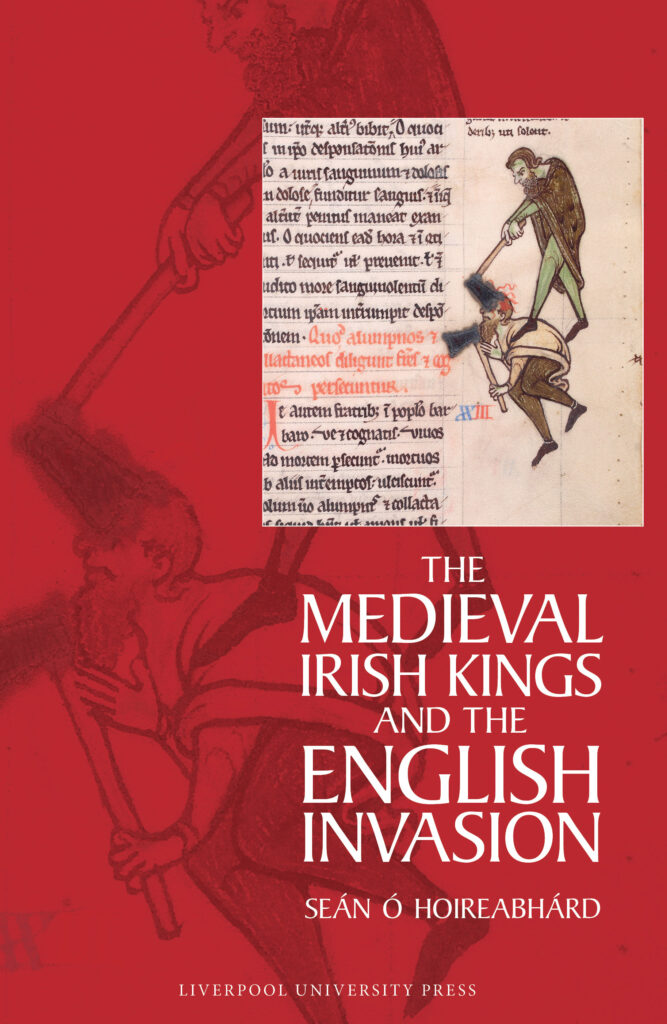SEÁN Ó HOIREABHÁRD
Liverpool University Press
£125
ISBN 9781835538449
REVIEWED BY
Simon Egan
Simon Egan is a lecturer in Medieval Irish History at Queen’s University Belfast.
It is no exaggeration to say that a significant body of work has been completed on the origins, course and impact of the English invasions of Ireland in the late 1160s. This incredibly welcome addition to the field forces us to rethink a good deal of what we know (or thought we knew) about these pivotal events. As the author demonstrates, much of the scholarship on the invasions (and high medieval Ireland more generally) has rested on particular assumptions. For example, it has often been presumed that the infamous Diarmait Mac Murchadha (d. 1171) was the main mover and shaker in Irish affairs on the eve of the invasions: he did, after all, help to induce an invasion that permanently altered the political and ethnic make-up of the island. This book dispels the notion that Mac Murchadha (and the kings of Leinster more generally after 1072) ranked among the most powerful of Irish rulers. It argues convincingly that the Uí Chennselaig kings of Leinster were, on the whole, minor players in Irish affairs. Power and the ambition to dominate the entire island were instead concentrated in the hands of the rulers of Munster, Connacht and Ulster.
The core aim of the book is to place the Irish kings at centre stage, thus challenging the dominant Anglocentric narratives of Gaelic reaction and retreat in the face of English conquest and colonisation. Seán Ó Hoireabhárd contends that Gaelic Ireland was a complex entity and that the English invasions of Ireland should be viewed as an intrusion into an equally complex world. The book is, broadly speaking, divided into five main sections, the first three of which focus on the fortunes of the respective rulers of Connacht, Munster and Ulster. Traditionally, the more powerful Irish kings have been viewed as ambitious but ultimately inept in their ability to secure long-term island-wide hegemony. Using the corpus of Irish annalistic material, Ó Hoireabhárd expertly reconstructs the careers of famous Irish kings (whom he aptly describes as ‘hegemons’), including Muircheartach Ó Briain of Thomond (d. 1119), Cormac Mac Cárthaigh of Desmond (d. 1138), Muircheartach Mac Lochlainn of Ulster (d. 1166) and Ruaidhrí Ó Conchobhair of Connacht (d. 1198). This is no easy task. The historiography of high medieval Ireland abounds in general surveys, but little work has been done to explore the wider dynastic and strategic considerations shaping the ambitions of these figures.
Rather than seeing the Irish kings as being ultimately doomed to failure in the face of the expanding English juggernaut, Ó Hoireabhárd makes a convincing case that Ireland’s leading kings were becoming more powerful during the twelfth century. A combination of careful dynastic and strategic planning (through the building of alliances), coupled with extensive military preparations (including the raising of sizeable fleets) and the seizure of strategic locations (such as crossing-points on the River Shannon), saw some of Ireland’s kings come very close to achieving supremacy. Poor decisions, along with bad luck in some cases, scuppered their chances, however. Ó Hoireabhárd places great emphasis on setting the rise of these kings within their respective regional and provincial contexts. The first three sections of the book provide some fascinating insights into the means by which the Uí Bhriain and Uí Chonchobhair sought to dominate their respective provinces before expanding outwards; likewise, Muircheartach Mac Lochlainn enjoyed an unprecedented level of power in Ulster prior to his demise in 1166. Indeed, with regard to Mac Lochlainn, had it not been for a series of ill-conceived decisions the Ulster king could well have made good his ambitions to dominate the entire island.
Sections 4 and 5 provide an illuminating discussion on the Irish institution of kingship and the impact of the English invasions. Again, this is a topic that has generated significant debate: scholars have explored the terminology pertaining to kingship and attempted to draw comparisons between the exercise of kingship in Ireland and debates on the so-called ‘feudal’ revolution in Europe. Ó Hoireabhárd focuses on the period often dubbed that of ‘high-kings with opposition’. He makes a very strong case for reconsidering what this era entailed by viewing the contest for the high-kingship within the context of Munster–Connacht–Ulster rivalry. While earlier scholars have drawn attention to the importance of this topic, Ó Hoireabhárd is the first to explore this from a systematic point of view (indeed, this chapter needs to be read alongside the first three chapters, which provide context crucial for unpicking the fascinating issue).
Overall, this is a hugely impressive piece of scholarship and, on a very obvious level, this volume will be essential reading for anyone working on the history or political culture of high medieval Ireland. It will also, however, have a much wider application. Ó Hoireabhárd has painstakingly reconstructed the affairs of the main contenders for power in twelfth-century Ireland. The book contains a wealth of information on the different dynasties and pays particularly close attention to each family’s origin-legend and ancestry. It is, moreover, supplemented with several detailed genealogies and maps, the latter delineating (in colour) all of the main dynastic groups and entities in high medieval Ireland. These resources alone will serve as an invaluable guide to anyone who has struggled to navigate the complex dynastic and lineage-based world of medieval Ireland. On a wider level, Ó Hoireabhárd’s book should also be a helpful reference point for scholars of medieval European history more generally, while historians of early modern Ireland can learn a great deal about their own periods from reading this study.

